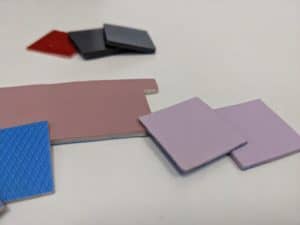thermal pads assortment
In our last blog, we discussed 3 tips to choosing a thermal gap filling pad. We wanted to show how that worked in a previous application. The below is a case study that utilizes a few of those tips.
The Problem:
A customer came to us looking for an thermal management solution for an application that was sensitive to outgassing that required the following:
-Electrical Isolation.
-Thermal Performance at low pressures.
-Some reinforcement to provide help during handling.
-A good price point.
-The gap needing to be filled was .062’’ .
Problem Solving:
- The gap filling need was .062’’. We planned to compress it 25-30%. A number of Gap Pad products are available in .080’’, including GPVOUS, GPHC3.0, GPHC5.0, and others.
- The Electrical Isolation was easy. Most thermal gap filling pads are electrically isolating, although not all – but most are. The above mentioned ones were all electrical isolating. So we picked from that pool.
- The problem with outgassing is many times on thermal gap filling pads there is little data. However, with Bergquist products, and other well known brands there is usually good data. In this case, we were able to find data on GPHC3.0 having extremely low outgassing data. See our Gap Pad outgassing blog.
(at this point we started deciding GPHC3.0 might be a good fit)
The Thermal Solution:
- GAP PAD HC3000 has a fiberglass insert to help with handling.
- GAP PAD HC3000 has great thermal performance at low pressures with a very low Youngs’ Modulus of 16 psi, and a low hardness- making it a great candidate for this type of application.
- GAP PAD HC3000 has a very good price point as a mid-range thermal performance product that can do the job without breaking the bank.
For more information on thermal pads, or you believe you have an application that could utilize a thermal gap filling pad, please contact sales@nedc.com.
Click for Datasheet for GAP PAD HC3000 is also known as GPHC3.0